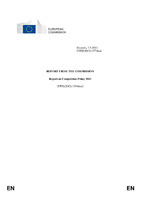| dc.description.abstract | The European Union (EU) is the world's largest economic and trading area. The EU's unique asset and distinct comparative advantage on the global scene is its Single Market, which encompasses over half a billion consumers and more than 20 million firms. Since its inception, the on-going process of improving and expanding the Single Market has gone hand in hand with the development of EU competition policy. The first seminal antitrust cases targeting impediments to trade in the Single Market date back to the 1960s, notably the pioneering decision in 1964 against Grundig-Consten. That case concerned an agreement to partition the market, which had resulted in substantial price differences between France and Germany. The Court of Justice upheld the Grundig-Consten decision and reiterated its position on private impediments to cross-border trade and competition in subsequent judgments1. The adoption of the merger control regulation in 1989 represented a qualitative leap in EU competition policy reflecting the development of the internal market after the entry into force of the Single European Act in 1987. EU competition policy took into account the new market realities of increased opportunities for European firms to merge and acquire assets across national borders. Likewise, State aid control has also gradually become an essential pillar of the Single Market, ensuring that companies are able to compete on equal terms independently of where they are located and providing safeguards against Member States engaging in mutual subsidy races at the expense of each other and of the general European interest. Finally, the adoption of Regulation 1/2003 ten years ago marked a new era in the enforcement of the EU antitrust rules, in which national competition authorities (NCAs) have become very active players. The enforcement of the EU antitrust rules is now carried out by a multiplicity of enforcers in the Single Market according to the same standard of assessment. That regime has significantly enhanced the level of enforcement of the EU antitrust rules and underpins the level playing field for companies operating cross-border in Europe. |

